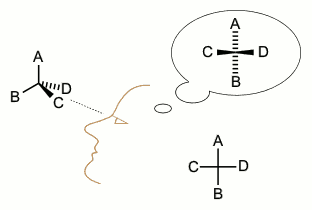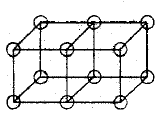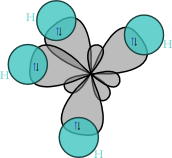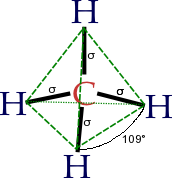This is an old revision of this page, as edited by Sadi Carnot (talk | contribs) at 12:01, 20 September 2006 (→21st century: fmt). The present address (URL) is a permanent link to this revision, which may differ significantly from the current revision.
Revision as of 12:01, 20 September 2006 by Sadi Carnot (talk | contribs) (→21st century: fmt)(diff) ← Previous revision | Latest revision (diff) | Newer revision → (diff)In chemistry, the history of the molecule traces the origins of the concept or idea of the existence, in nature, of a bonded structure of two or more atoms, according to which the structures of the universe are built. In a sense, the concept of united atoms, i.e. molecules, traces it origins back the 5th century BC views of the Greek philosopher Leucippus who argued that all the universe is composed of atoms and voids. In about 450 BC, the Greek Empedocles introduced the idea of the four "roots" of things: fire, air, water, and earth; and two "forces", attraction and repulsion, which function to join and separate the four roots. Thus, it can be argued that, from this point onward, people have speculated as to how atoms or roots might unite in combination.

Etymology
According to Merriam-Webster and the Online Etymology Dictionary, the word "molecule" derives from the Latin "moles" or small unit of mass, which is akin to the Greek molos, meaning exertion (c.1548) possibly referring to fact that it takes a certain amount of exertion effort to lift a small mass; or specifically:
- Molecule (1794) - "extremely minute particle," from Fr. moléclue (1678), from Mod.L. molecula, dim. of L. moles "mass, barrier". A vague meaning at first; the vogue for the word (used until late 18th century only in Latin form) can be traced to the philosophy of Descartes.
Early views
Prior to the development of the concept of the "molecule" were the various essential element theories. In the early 6th century BC, the Greek scientist Thales of Miletus reasoned that essential element was water and that all things derived from this element. According to legend, Thales was walking along a hillside path on the shore of Ionia, in what is now called south-western Turkey, and he noticed some rocks which contained fossils of what were unmistakably seashells. This led Thales to believe that the hills must have once been part of the sea. On this logic, Thales reasoned that the original world must have been entirely water, and that this was the essential element.
In the 5th century BC, the Greek Empedocles, being influenced by Pythagoras, claimed that all things consisted of differing combinations of four elements:

Adding to the four elements of the Greeks, in about 350 BC, Aristotle both coined the term “element” and conceived of a fifth element called "quintessence", which formed the heavens. Building on this logic, various writers over the years have speculated on possible geometric shapes, such as circles, squares, and polygons, etc., of elements and how these shapes might combine, separate, or possibly rub against each other to create new elements over evolutionary periods.
17th century
One of the earliest molecular theories was that put forward by the famous French naturalist Rene Descartes who believed that some atoms were furnished with hook-like projections, and others, with eye-like ones. He held that two atoms combined when the hook of one got caught in the eye of the other, such as shown below:
In a more concrete manner, however, the concept of aggregates or units of bonded atoms, i.e. "molecules", traces its origins to Robert Boyle's 1661 hypothesis, in his famous treatise The Sceptical Chymist, that matter is composed of clusters of particles and that chemical change results from the rearrangement of the clusters. Boyle argued that matter's basic elements consisted of various sorts and sizes of particles, called "corpuscles", which were capable of arranging themselves into groups.
18th century
An early precursor to the idea of bonded "combinations of atoms", was the theory of "combination via chemical affinity". For example, in 1718, building on Boyle’s conception of combinations of clusters, the French chemist Étienne François Geoffroy developed theories of chemical affinity to explain combinations of particles, reasoning that a certain alchemical “force” draws certain alchemical components together. Geoffroy's name is best known in connection with his tables of "affinities" (tables des rapports), which he presented to the French Academy in 1718 and 1720.

These were lists, prepared by collating observations on the actions of substances one upon another, showing the varying degrees of affinity exhibited by analogous bodies for different reagents. These tables retained their vogue for the rest of the century, until displaced by the profounder conceptions introduced by CL Berthollet. In 1789, William Higgins published views on what he called combinations of "ultimate" particles, which foreshadowed the concept of valency bonds. If, for example, according to Higgins, the force between the ultimate particle of oxygen and the ultimate particle of nitrogen were 6, then the strength of the force would be divided accordingly, and similarly for the other combinations of ultimate particles:

19th century
Similar to these views, in 1803 John Dalton took the atomic weight of hydrogen, the lightest element, as unity, and determined, for example, that the ratio for nitrous anhydride was 2 to 3 which gives the formula N2O3. Interestingly, Dalton incorrectly imagined that atoms “hooked” together to form molecules. Later, in 1808, Dalton published his famous diagram of combined "atoms":
In Amedeo Avogadro's famous 1811 paper "Essay on Determining the Relative Masses of the Elementary Molecules of Bodies", he essentially states, i.e. according to Partington's A Short History of Chemistry, that:
The smallest particles of gases are not necessarily simple atoms, but are made up of a certain number of these atoms united by attraction to form a single molecule.
It must be noted here that this quote is a literal translation. Avogadro uses the name "molecule" for both atoms and molecules. Specifically, he uses the name "elementary molecule" when referring to atoms and to complicate the matter also speaks of "compound molecules" and "composite molecules".
During his stay in Vercelli Avogadro wrote a concise note (memoria) in which he declared the hypothesis of what we now call Avogadro's law: equal volumes of gases, at the same temperature and pressure, contain the same number of molecules. This law implies that the relationship occurring between the weights of same volumes of different gases, at the same temperature and pressure, corresponds to the relationship between respective molecular weights. Hence, relative molecular masses could now be calculated from the masses of gas samples.
Avogadro developed this hypothesis in order to reconcile Joseph Louis Gay-Lussac's 1808 law on volumes and combining gases with Dalton's 1803 atomic theory. The greatest difficulty Avogadro had to resolve was the huge confusion at that time regarding atoms and molecules – one of the most important contributions of Avogadro's work was clearly distinguishing one from the other, admitting that simple particles too could be composed of molecules, and that these are composed of atoms. Dalton, by contrast, did not consider this possibility. Curiously, Avogadro considers only molecules containing even numbers of atoms; he does not say why odd numbers are left out?
In 1826, building on the work of Avogadro, the French chemist Jean-Baptiste Dumas states:
Gases in similar circumstances are composed of molecules or atoms placed at the same distance, which is the same as saying that they contain the same number in the same volume.
In coordination with these concepts, in 1833 the french chemist Marc-Antoine-Auguste Gaudin presented a clear account of Avogadro's hypothesis, regarding atomic weights, by making use of “volume diagrams”, which clearly show both semi-correct molecular geometries, such as a linear water molecule, and correct molecular formulas, such as H2O:

In 1863, an unknown Vienna high-school teacher named Joseph Loschmidt published, at his own expense, a booklet entitled Chemische Studine I (see: article), containing pioneering molecular images which showed both "ringed" structures as well as double-bonded structures, such as:

It is argued that Loschmidt's ringed molecular images formed the seed of thought for August Kekule's story of how he "dreamed up" the benzene ring structure. An often-repeated story claims that after years of studying carbon bonding, benzene and related molecules, he dreamt one night of the Ouroboros, a snake eating its own tail, and that upon waking he was inspired to deduce the ring structure of benzene. The story, however, first appeared in the Berichte der Durstigen Chemischen Gesellschaft (Journal of the Thirsty Chemical Society), a parody of the Berichte der Deutschen Chemischen Gesellschaft, which appeared annually in the late-19th century on the occasion of the congress of German chemists; as such, it is probably to be treated with circumspection.
While his (more formal) claims were well-publicized and accepted, biographers came to the conclusion that Kekulé's understanding of the tetravalent nature of carbon bonding depended on the previous research of Archibald Scott Couper and Josef Loschmidt. The cyclic nature of benzene was finally confirmed by the eminent crystallographer Kathleen Lonsdale. Benzene presents a special problem in that, to account for all the bonds, there must be alternating double carbon bonds:

In 1894, Emil Fischer postulated the famous "Lock and Key" molecule bonding theory. According to this theory molecules fit togethter according to complementary geometric shape. Enzymes, for example, are very specific, and Fischer suggested that this was because both the enzyme and the substrate possess specific complementary geometric shapes that fit exactly into one another. This is often referred to as "the lock and key" model. An enzyme combines with its substrate(s) to form a short-lived enzyme-substrate complex. However, while this model explains enzyme specificity, it fails to explain the stabilization of the transition state which occurs.

Later, Fisher developed the Fisher projection technique for viewing 3-D molecules on a 2-D sheet of paper:
 ,
,
20th century
In the early 1900s, the American chemist Gilbert Lewis began to use dots in lecture, while teaching undergraduates at Harvard, to represent the electrons around atoms. His students favored these drawings, which stimulated him in this direction. From these lectures, Lewis noted that elements with a certain number of electrons seemed to have a special stability. To Lewis it appeared that once a core of eight electrons has formed around a nucleus, the layer is filled, and a new layer is started. Lewis also noted that various ions with eight electrons also seemed to have a special stability. On these views, he proposed the rule of eight or octet rule: Ions or atoms with a filled layer of eight electrons have a special stability.
Moreover, noting that a cube has eight corners Lewis envisioned an atom as having eight sides available for electrons, like the corner of a cube. Subsequently, in 1902 he devised a conception in which cubic atoms can bond on their sides to form cubic-structured molecules:

In other words, electron-pair bonds are formed when two atoms share an edge, as in structure C below. This results in the sharing of two electrons. Similarly, charged ionic-bonds are formed by the transfer of an electron from one cube to another, without sharing an edge A. An intermediate state B where only one corner is shared was also postulated by Lewis.

Double bonds are formed by sharing a face between two cubic atoms. This results in sharing four electrons:

About ten years later, while working as the chair of the department of chemistry at the University of California at Berkeley, Lewis read a paper by an English graduate student, Alfred Parson, who was visiting Berkeley for a year. In this paper, Parson suggested that a chemical bond results from two electrons being shared between two atoms. This, according to Lewis, meant that bonding occurred when two electrons formed a shared edge between two complete cubes.
On these views, in his famous 1916 article The Molecule and the Atom, Lewis introduced the “Lewis structure” to represent atoms and molecules, where dots represent electrons and lines represent covalent bonds. Moreover, he proposed that an atom tended to form an ion by gaining or losing the number of electrons needed to complete a cube. Thus, Lewis structures show each atom in the structure of the molecule using its chemical symbol. Lines are drawn between atoms that are bonded to one another; occasionally, pairs of dots are used instead of lines. Excess electrons that form lone pairs are represented as pair of dots, and are placed next to the atoms on which they reside:

To summarize his views on his new bonding model, Lewis states:
Two atoms may conform to the rule of eight, or the octet rule, not only by the transfer of electrons from one atom to another, but also by sharing one or more pairs of electrons...Two electrons thus coupled together, when lying between two atomic centers, and held jointly in the shells of the two atoms, I have considered to be the chemical bond. We thus have a concrete picture of that physical entity, that "hook and eye" which is part of the creed of the organic chemist.
The following year, in 1917, an unknown American undergraduate chemical engineer named Linus Pauling was learning the Dalton hook-and-eye bonding method at the Oregon Agricultural College, which was the vogue description of bonds between atoms at the time. Each atom had a certain number of hooks that allowed it to attach to other atoms, and a certain number of eyes that allowed other atoms to attach to it. A chemical bond resulted when a hook and eye connected. Pauling, however, wasn't satisfied with this archaic method and looked to the newly-emerging field of quantum physics for a new method.
Subsequently, in 1931, building on theories found in Lewis' famous article, Pauling published his ground-breaking article "The Nature of the Chemical Bond" (see: article) in which he used quantum mechanics to calculate properties and structures of molecules, such as angles between bonds and rotation about bonds. On these concepts, Lewis developed hybridization theory to account for bonds in molecules such as CH4, in which four sp³ hybridised orbitals are overlapped by hydrogen's 1s orbital, yielding four sigma (σ) bonds. The four bonds are of the same length and strength, which yields a molecular structure as shown below:
 translates into
translates into 
Owing to these exceptional theories, Pauling has been the only person two ever win two unshared Nobel prizes
In 1937, chemist K.L Wolf introduced the concept of supermolecules (Übermoleküle) to describe hydrogen bonding in acetic acid dimers. Supermolecules are organized polymolecular systems, held together by non-covalent interactions. Examples of a supermolecules are the Cyclodextrins, which have a cavity in which a guest molecule can fit:

In the mid-twentieth century, neurochemists began to discover molecules that have function in human brain activity. In 1948, for example, Maurice M. Rapport isolated and named the now-famous structure “serotonin”. In the central nervous system, serotonin is believed to play an important role in the regulation of mood, sleep, emesis, sexuality, and appetite. By many accounts, serotonin is considered the “confidence chemical”, in that, for example, cerebral levels of this neurochemical are higher in alpha-males and alpha-females, such as captains, group leaders, and high-ranking chimpanzees in troop hierarchies. Moreover, during the first six months of being in love, paradoxically, serotonin levels in couples drop to 40 percent below those in normal subjects:
-
 Molecular-structure of serotonin (1948)
Molecular-structure of serotonin (1948)
-
 3D-structure of serotonin C10H12N2O
3D-structure of serotonin C10H12N2O
In 1953, American scientists James Watson and Francis Crick determined the molecular structure of DNA or “deoxyribonucleic acid”, which consists of a pair of molecules, organized as strands running start-to-end and joined by hydrogen bonds along their lengths. Each strand is a chain of chemical "building blocks", called nucleotides, of which there are four types: adenine (abbreviated A), cytosine (C), guanine (G) and thymine (T). These molcular strands links together in the form a spiral structure, as shown below:

In 1958, the American biochemist George Wald and his co-workers discovered that a photosensitive molecule in the rod cells of the eye, called retinal C20H28O, straightens its configuration in response to light, i.e. photons. This straightened configuration results to trigger a nerve impulse; statistically it takes five photons to trigger such a nerve impulse. This is the core mechanism of the vision process:

For his work, Wald won a share of the 1967 Nobel Prize in Physiology or Medicine with Haldan Keffer Hartline and Ragnar Granit.
During the later half of the twentieth century, computer technologies began to increase; this led to the determination of larger molecular structures such as proteins. In 1958, for example, the structure of the myoglobin molecule was determined using X-ray crystallography by Max Perutz and Sir John Cowdery Kendrew, as shown below, where the colored segments are alpha helices:

Perutz and Kendrew received the Nobel Prize in Chemistry for determining the structure of this molecule.
In 1985, Harold Kroto of the University of Sussex, and James Heath, Sean O'Brien, Robert Curl and Richard Smalley, from Rice University, discovered C60 or what is famously known as a "buckyball":

In molecular beam experiments, discrete peaks were observed corresponding to molecules with the exact mass of sixty or seventy or more carbon atoms. Shortly thereafter came the discover the fullerenes. Kroto, Curl, and Smalley were awarded the 1996 Nobel Prize in Chemistry for their roles in the discovery of this class of compounds. C60. Other fullerenes were later noticed occurring outside of a laboratory environment, e.g., such as in normal candle soot.
In 1999, researchers from the University of Vienna demonstrated that the wave-particle duality applied to macro-molecules such as fullerene.
21st century
On the cutting edge is nanotechnology, which is the science and engineering of matter at the atomic scale. In other words, recent areas of interest in the molecular world have been to build functionable molecules atom-by-atom, such as, for example, a molecular gear:
In June of 2004, scientists from China's Tsinghua University and Louisiana State University demonstrated the use of nanotubes in incandescent lamps, replacing a tungsten filament in a lightbulb with a carbon nanotube one:

In September of 2005, a research team, led by Ludwig Bartel at the University of California Riverside designed a molecule that walks over a surface like a human, i.e. a walking molecule. The molecule, 9,10-dithioanthracene or “DTA”, has two linkers that act as feet. With a source of thermal energy, the molecule moves such that only one of the linkers is lifted from the surface while the other stabilizes the molecule and guides its motion. By alternating its two feet, the nano-walker is able to move over atomic surfaces without the assistance of nano-rails or atomic-groves.
Similarly, in October of 2005, researchers at Rice University designed the world's first molecular car. With a wheelbase of less than 5 nm, the tiny atom-sized car was driven on a gold-plated microscopic highway. The wheels were buckyballs, spheres of pure carbon containing 60 atoms a piece. According to these researchers, this "nanocar" represents the first step towards molecular manufacturing.
The modern theory of molecules makes great use of the many numerical techniques offered by computational chemistry. Dozens of molecules have now been identified in interstellar space by microwave spectroscopy.
See also
References
- Fischer E. (1894). "Einfluss der Configuration auf die Wirkung der Enzyme". Ber. Dt. Chem. Ges. 27: 2985–2993.
{{cite journal}}: line feed character in|journal=at position 9 (help) - Cobb, Cathy (1995). Creations of Fire - Chemistry's Lively History From Alchemy to the Atomic Age. Perseus Publishing. ISBN 073820594X.
- "Valence and The Structure of Atoms and Molecules", G. N. Lewis, American Chemical Society Monograph Series, page 79 and 81.
- ^ Butler, John M. (2001) Forensic DNA Typing "Elsevier". pp. 14-15. ISBN 012147951X.
- Kendrew JC, Bodo G, Dintzis HM, Parrish RG, Wyckoff H, Phillips DC. (1958). A three-dimensional model of the myoglobin molecule obtained by x-ray analysis. Nature 181(4610):662-6.
- Arndt, M. (1999). "Wave-particle duality of C60". Nature. 401: 680–682.
{{cite journal}}: Unknown parameter|coauthors=ignored (|author=suggested) (help); Unknown parameter|month=ignored (help) - Pittalwala, M. (2005). Molecule Walks Like a Human, Sept., Source: UCR Newsroom, Sept. 26
- Lamba, R. (2005) Scientist Build World's First Molecular car, Oct. Source: physOrg.com
Further reading
- Partington, J.R. (1989). A Short History of Chemistry. Dover Publications, Inc. ISBN 0486659771.</ref>
- Atkins, Peter (2003). Atkins' Molecules, 2nd Ed. Cambridge University Press. ISBN 0521535360.</ref>
- Sargent, Ted (2006). The Dance of Molecules - How Nanotechnology is Changing our Lives. Thunder's Mouth Press. ISBN 1560258098.</ref>
External links
- Geometric Structures of Molecules - Middlebury College
- Atoms and Molecules - McMaster University
- Human Molecule, Earth Molecule, and Sun Molecule - Institute of Human Thermodynamics
- Molecular Evolution Table - Institute of Human Thermodynamics
Articles
- Molecules Used to Make Nano-sized Containers - TRN Newswire
- Molecular Computer Processors - HP Labs